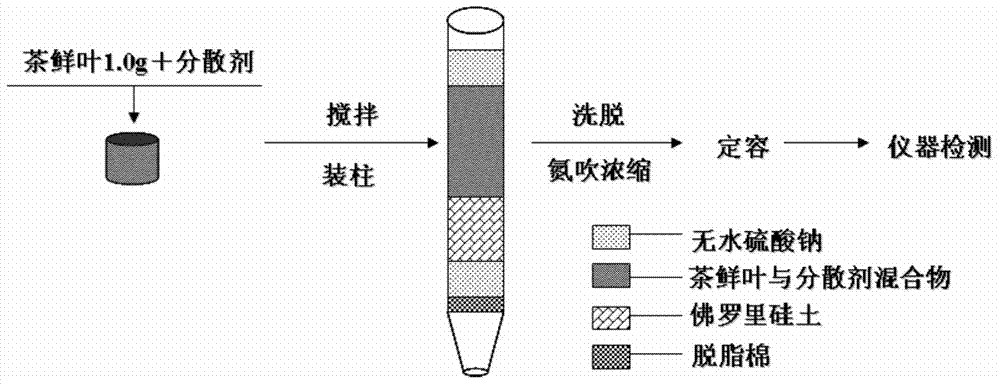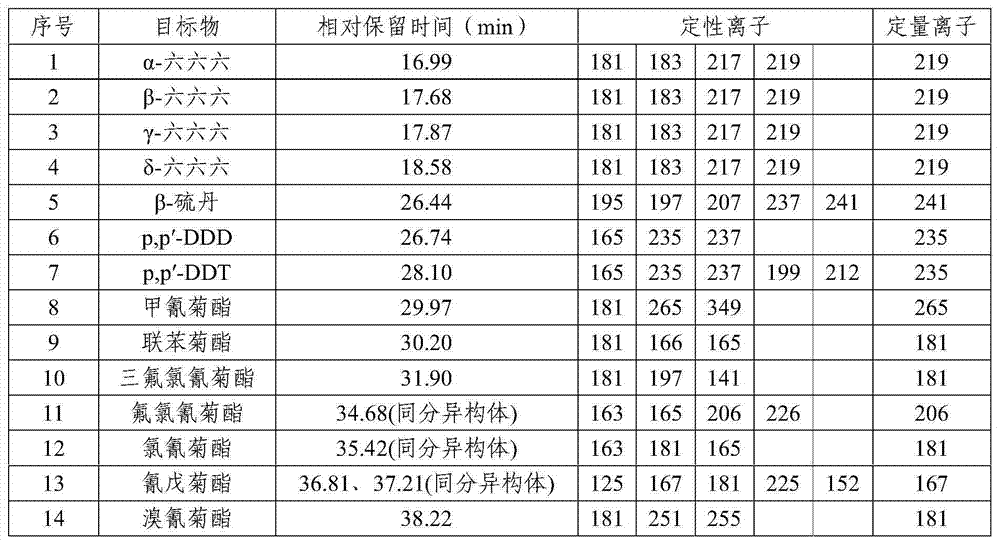Pretreatment method for detecting pesticide residues in fresh tea leaves
A technology for pesticide residues and fresh tea leaves, which is applied in the pretreatment field of matrix solid-phase dispersion detection of pesticide residues in fresh tea leaves, can solve the problems of 3.0-3.5 hours, expensive solid-phase extraction columns, and hazards to environmental analysts, etc. Problems, to achieve the effect of strengthening practical value and social significance, eliminating complex matrix interference, and reducing losses
Active Publication Date: 2014-06-18
HUNAN AGRICULTURAL UNIV
View PDF5 Cites 8 Cited by
- Summary
- Abstract
- Description
- Claims
- Application Information
AI Technical Summary
Problems solved by technology
The classic sample pretreatment methods such as Soxhlet extraction and liquid-liquid extraction are cumbersome, time-consuming, consume a lot of organic solvents, and the extraction efficiency is low
Similarly, the current GB / T23205-2008 and GB / T23204-2008 national standard methods are aimed at finished tea leaves, and simultaneously determine 448 and 519 pesticide residues, all of which use acetonitrile high-speed homogenate extraction-solid phase extraction The column purification method also has the following problems: 1. It is complicated and time-consuming, generally takes 3.0-3.5 hours; 2. The cost is high, and the solid-phase extraction column used in the purification process is expensive (100-120 yuan / piece) , and can only be used once; 3. The toxic and harmful organic solvents are consumed in the pretreatment process (80-120 ml), which will cause harm to the environment and analysts
Method used
the structure of the environmentally friendly knitted fabric provided by the present invention; figure 2 Flow chart of the yarn wrapping machine for environmentally friendly knitted fabrics and storage devices; image 3 Is the parameter map of the yarn covering machine
View moreImage
Smart Image Click on the blue labels to locate them in the text.
Smart ImageViewing Examples
Examples
Experimental program
Comparison scheme
Effect test
Embodiment 1
[0032] Example 1 Determination of 7 kinds of organochlorine pesticides and 7 kinds of pyrethroid pesticide residues in fresh tea leaves
the structure of the environmentally friendly knitted fabric provided by the present invention; figure 2 Flow chart of the yarn wrapping machine for environmentally friendly knitted fabrics and storage devices; image 3 Is the parameter map of the yarn covering machine
Login to View More PUM
| Property | Measurement | Unit |
|---|---|---|
| ion source temperature | aaaaa | aaaaa |
| correlation coefficient | aaaaa | aaaaa |
Login to View More
Abstract
The invention provides a pretreatment method for detecting pesticide residues in fresh tea leaves. The method comprises the following steps: selecting a dispersing agent which has high adsorptive property on pesticides such as organic chloride and pyrethroid, directly mixing and grinding the dispersing agent with a fresh leaf sample, so that the cell disruption degree of the sample is improved, and the sample is finally uniformly dispersed; obtaining a mixture in a half-dry state and taking the mixture as a filler, feeding the filler in a chromatographic column in which a certain amount of adsorbents and water removal agents are fed in advance, eluting by using a mixed organic solvent, concentrating an eluant, so that the eluant can be directly subjected to instrumental analysis. According to the method, the operations of extraction and purification of the sample are integrated, and loss of the measured substance caused by sample homogenization, precipitation, centrifugation, dissolution, emulsification and concentration is avoided. Moreover, the method is simple and convenient to operate, high in recovery rate, small in solvent consumption and low in analysis cost and is a green and environment-friendly sample pretreatment method.
Description
technical field [0001] The invention relates to the field of safety detection of agricultural products, in particular to a pretreatment method for detection of pesticide residues in fresh tea leaves by matrix solid-phase dispersion. Background technique [0002] Tea is recognized as the national drink of China and a cultural symbol that Chinese people are proud of. my country has become the world's largest tea-producing country. In 2012, the area of tea gardens reached 2,385,200 hectares, and the output of tea reached 1.78 million tons. Tea drinking has become a living habit of most Chinese people, and tea has become an indispensable health drink and spiritual drink in social life. Moreover, with the popularization of people's healthy consumption concept, tea is being accepted, loved and pursued by more and more people. However, tea export has been facing serious non-tariff barriers in terms of quality and safety, involving heavy metals, pesticide residues and microorgan...
Claims
the structure of the environmentally friendly knitted fabric provided by the present invention; figure 2 Flow chart of the yarn wrapping machine for environmentally friendly knitted fabrics and storage devices; image 3 Is the parameter map of the yarn covering machine
Login to View More Application Information
Patent Timeline
 Login to View More
Login to View More Patent Type & Authority Applications(China)
IPC IPC(8): G01N30/06G01N30/88
Inventor 谭君刘仲华黄建安
Owner HUNAN AGRICULTURAL UNIV
Features
- R&D
- Intellectual Property
- Life Sciences
- Materials
- Tech Scout
Why Patsnap Eureka
- Unparalleled Data Quality
- Higher Quality Content
- 60% Fewer Hallucinations
Social media
Patsnap Eureka Blog
Learn More Browse by: Latest US Patents, China's latest patents, Technical Efficacy Thesaurus, Application Domain, Technology Topic, Popular Technical Reports.
© 2025 PatSnap. All rights reserved.Legal|Privacy policy|Modern Slavery Act Transparency Statement|Sitemap|About US| Contact US: help@patsnap.com



